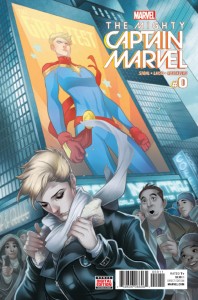 The Mighty Captain Marvel #0 — Writer: Margaret Stohl; Art: Emilio Laiso and Ramon Rosanas; Colors: Rachelle Rosenberg
The Mighty Captain Marvel #0 — Writer: Margaret Stohl; Art: Emilio Laiso and Ramon Rosanas; Colors: Rachelle Rosenberg
The Ultimates2 #2 — Writer: Al Ewing; Art: Travel Foreman; Colors: Dan Brown
Invincible Iron Man #2 — Writer: Brian Michael Bendis; Art: Stefano Caselli; Colors: Marte Gracia
Hellcat #13 — Writer: Kate Leth; Art: Brittney L. Williams; Colors: Rachelle Rosenberg
As they have so often lately, the Marvel women lead off the week. The Mighty Captain Marvel picks up after Civil War II, with Carol 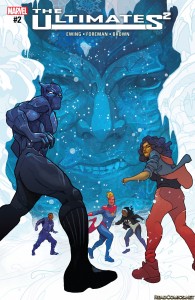 Danvers the best-known, and one of the most powerful, people on the planet; she and Alpha Flight form an orbiting first line of defense against outer-space invasion, and a sort of Ellis Island for alien refugees (cue immigrant symbolism), but the pressure’s getting to her in the form of bad dreams…. This offers the setting- and character-building you’d expect in a “0” issue, enough to make the ongoing series’s premise clear, and get readers to buy it (although it’s curious that Marvel was too cheap to cut a buck or two off the cover price, to spur curious-but-penny-pinching fans). Ultimates2 also features Captain Marvel, as she and Black Panther get pulled into a meta-cosmic adventure that begins to tie up threads sewn in this book’s last volume, involving Eternity, the reverse-polarized Galactus, the Living Tribunal, the Lords of Chaos and Order, and
Danvers the best-known, and one of the most powerful, people on the planet; she and Alpha Flight form an orbiting first line of defense against outer-space invasion, and a sort of Ellis Island for alien refugees (cue immigrant symbolism), but the pressure’s getting to her in the form of bad dreams…. This offers the setting- and character-building you’d expect in a “0” issue, enough to make the ongoing series’s premise clear, and get readers to buy it (although it’s curious that Marvel was too cheap to cut a buck or two off the cover price, to spur curious-but-penny-pinching fans). Ultimates2 also features Captain Marvel, as she and Black Panther get pulled into a meta-cosmic adventure that begins to tie up threads sewn in this book’s last volume, involving Eternity, the reverse-polarized Galactus, the Living Tribunal, the Lords of Chaos and Order, and 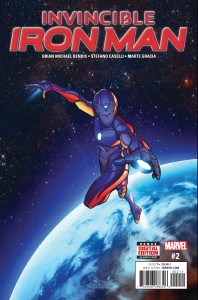 the rest of the Ultimates team: Miss America Chavez, Blue Marvel and Spectrum. Ewing’s gotten as good as Abnett and Lanning at the cosmic stuff (he’s almost up to Jim Starlin level), while Foreman and Brown give the visuals a solid grounding for the normal human elements, and a hallucinatory sheen for the cosmic parts. Invincible Iron Man sees Riri Williams, 15 years old, learning the ropes of the iron-clad superhero game thanks to Tony Stark, who may be MIA in body, but has downloaded an AI program for her suit that mimics his personality and knowledge, becoming, in effect, her Jarvis. This is a solid set-up for the comic, at least for a while, with Bendis doing his usual smooth job on the dialogue and action; good Iron Man artists have to be able to make both
the rest of the Ultimates team: Miss America Chavez, Blue Marvel and Spectrum. Ewing’s gotten as good as Abnett and Lanning at the cosmic stuff (he’s almost up to Jim Starlin level), while Foreman and Brown give the visuals a solid grounding for the normal human elements, and a hallucinatory sheen for the cosmic parts. Invincible Iron Man sees Riri Williams, 15 years old, learning the ropes of the iron-clad superhero game thanks to Tony Stark, who may be MIA in body, but has downloaded an AI program for her suit that mimics his personality and knowledge, becoming, in effect, her Jarvis. This is a solid set-up for the comic, at least for a while, with Bendis doing his usual smooth job on the dialogue and action; good Iron Man artists have to be able to make both 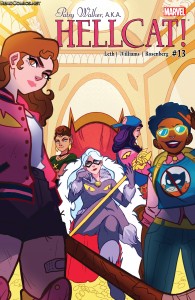 technology and people good-looking, and Caselli passes that test, so right now this book is doing everything it should. Hellcat is solidly in the Moon Girl/Squirrel Girl wing of the Marvel Universe, with brightly-colored panels and cartoony drawing making it attractive to middle- and high-school readers, while a solid foundation in Marvel continuity and some smart scripting make it work for older fans, too; like those two books, it’s criminally under-read by the Wednesday scan-the-new-racks crowd, but the vein it’s mining is both interesting and important, and if you’re a comics fan you really owe it to yourself to check out an issue.
technology and people good-looking, and Caselli passes that test, so right now this book is doing everything it should. Hellcat is solidly in the Moon Girl/Squirrel Girl wing of the Marvel Universe, with brightly-colored panels and cartoony drawing making it attractive to middle- and high-school readers, while a solid foundation in Marvel continuity and some smart scripting make it work for older fans, too; like those two books, it’s criminally under-read by the Wednesday scan-the-new-racks crowd, but the vein it’s mining is both interesting and important, and if you’re a comics fan you really owe it to yourself to check out an issue.
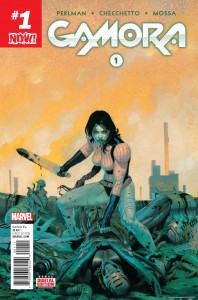 Gamora #1 — Writer: Nicole Perlman; Art: Marco Checchetto; Colors: Andres Mossa
Gamora #1 — Writer: Nicole Perlman; Art: Marco Checchetto; Colors: Andres Mossa
Star-Lord #1 — Writer: Chip Zdarsky; Art: Kris Anka; Colors: Matthew Wilson
Thanos #2 — Writer: Jeff Lemire; Art: Mike Deodato; Colors: Frank Martin
Silver Surfer #8 — Writer: Dan Slott; Art: Michael Allred; Colors: Laura Allred
These books all have an outer-space cosmic theme going. Gamora could also get grouped with the Marvel 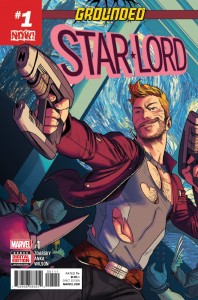 females, but offers much more straight-ahead superhero work: a solo series covering the early career of the Guardians of the Galaxy warrior woman, with both Thanos and her space-sister Nebula in the cast; if you liked, say, the Jason Aaron/Esad Ribic Thor stories, the Perlman/Checchetto team here should make you happy, too. Star-Lord is set in present continuity, which means that its lead character is currently stuck on Earth, with the other Guardians mad at him (see: stuck on Earth…), and only two people on the planet that he knows: Kitty Pryde and Howard the Duck, neither of whom has time for him right now. This leads, naturally, to a drinking bout with the Old Man Logan version of Wolverine, and the story escalates from there. The
females, but offers much more straight-ahead superhero work: a solo series covering the early career of the Guardians of the Galaxy warrior woman, with both Thanos and her space-sister Nebula in the cast; if you liked, say, the Jason Aaron/Esad Ribic Thor stories, the Perlman/Checchetto team here should make you happy, too. Star-Lord is set in present continuity, which means that its lead character is currently stuck on Earth, with the other Guardians mad at him (see: stuck on Earth…), and only two people on the planet that he knows: Kitty Pryde and Howard the Duck, neither of whom has time for him right now. This leads, naturally, to a drinking bout with the Old Man Logan version of Wolverine, and the story escalates from there. The  fish-out-of-water stuff plays well, as does the opportunity to have random Marvel characters show up, and there’s enough light charm here to carry the book along. Thanos has a deficit in the “light charm” department, with its death-worshipping title character more likely to eat or crush that butterfly on his cover than admire it, and Lemire and Deodato give us a Titan who’s dying himself, and searching for a cure, as his son assembles a team of super-powered assassins who have a grudge against the cosmic bad guy (along with everyone else in the universe) to try to take him down. Obviously, they aren’t going to succeed (one of the disadvantages of having the villain be the star of your book), but
fish-out-of-water stuff plays well, as does the opportunity to have random Marvel characters show up, and there’s enough light charm here to carry the book along. Thanos has a deficit in the “light charm” department, with its death-worshipping title character more likely to eat or crush that butterfly on his cover than admire it, and Lemire and Deodato give us a Titan who’s dying himself, and searching for a cure, as his son assembles a team of super-powered assassins who have a grudge against the cosmic bad guy (along with everyone else in the universe) to try to take him down. Obviously, they aren’t going to succeed (one of the disadvantages of having the villain be the star of your book), but 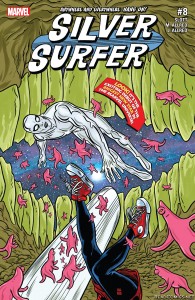 it’s fun to watch them try. Silver Surfer goes back to the “light charm” corner of the multiverse, with the Surfer and his companion/lover getting swallowed by a space whale, and telling its internal inhabitants stories to keep them occupied; as always, the Allred art (and the scripts by Slott, very different from his Amazing Spider-Man style) make this worth reading — or giving as a gift, especially since it’s a self-contained, all-ages story that requires no background knowledge, and is colorful and flashy enough to fascinate younger fans.
it’s fun to watch them try. Silver Surfer goes back to the “light charm” corner of the multiverse, with the Surfer and his companion/lover getting swallowed by a space whale, and telling its internal inhabitants stories to keep them occupied; as always, the Allred art (and the scripts by Slott, very different from his Amazing Spider-Man style) make this worth reading — or giving as a gift, especially since it’s a self-contained, all-ages story that requires no background knowledge, and is colorful and flashy enough to fascinate younger fans.
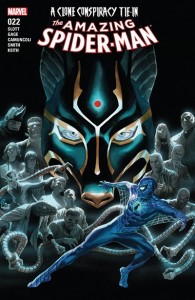 Amazing Spider-Man #22 — Writers: Dan Slott and Christos Gage; Pencils: Giuseppe Camuncoli; Inks: Cam Smith; Colors: Jason Keith
Amazing Spider-Man #22 — Writers: Dan Slott and Christos Gage; Pencils: Giuseppe Camuncoli; Inks: Cam Smith; Colors: Jason Keith
Doctor Strange #15 — Writer: Jason Aaron; Art: Chris bachalo and Jorge Fornes; Inks: John Livesay, Tim Townsend, Al Vey, Victor Olazaba and Jorge Fornes; Colors: Antonio Fabela
Avengers #2.1 — Writer: Mark Waid; Pencils: Barry Kitson; Inks: Mark Farmer; Colors: Jordan Boyd
Black Panther: World of Wakanda #2 — Writer: Roxane Gay; Pencils: Alitha E. Martinez; Inks:  Roberto Poggi and Alitha E. Martinez; Colors: Rachelle Rosenberg
Roberto Poggi and Alitha E. Martinez; Colors: Rachelle Rosenberg
Cage! #3 (of 4) — Writer/Pencils: Genndy Tartakovsky; Inks: Stephen DeStefano; Colors: Scott Wills
Uncanny X-Men #16 — Writer: Cullen Bunn; Pencils: Edgar Salazar; Inks: Ed Tadeo with Edgar Salazar; Colors: Nolan Woodard
Punisher #7 — Writer: Becky Cloonan; Art: Steve Dillon and Matt Horak; Colors: Frank Martin
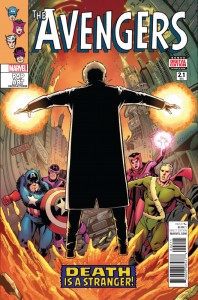 Of the other Marvels, Amazing Spider-Man continues its “Clone Conspiracy” storyline, with the true identity of the Jackal revealed (no, it’s not Uncle Ben, although that might have been cool…), and Peter tempted to join his crusade; it’s still one of the best mainstream-superhero books on the stands, with its large supporting cast and Slott’s ability to craft interesting plots that build on past continuity without merely repeating it. Doctor Strange is in the middle of one of those plots where everyone is taking their shot at the Doc — first Nightmare, then Satana, then the Orb, and now Baron Mordo and an even-bigger foe; the
Of the other Marvels, Amazing Spider-Man continues its “Clone Conspiracy” storyline, with the true identity of the Jackal revealed (no, it’s not Uncle Ben, although that might have been cool…), and Peter tempted to join his crusade; it’s still one of the best mainstream-superhero books on the stands, with its large supporting cast and Slott’s ability to craft interesting plots that build on past continuity without merely repeating it. Doctor Strange is in the middle of one of those plots where everyone is taking their shot at the Doc — first Nightmare, then Satana, then the Orb, and now Baron Mordo and an even-bigger foe; the 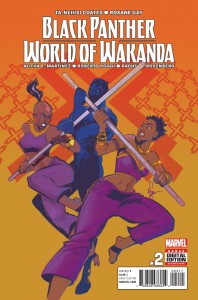 Aaron/Bachalo team makes all of this good-looking and compelling, especially with most magic gone or changed, and Strange reduced to punching and hacking more than spell-casting; if you aren’t following this comic, you’re missing one of its better runs. Avengers #2.1 is Mark Waid using his continuity-fu to imagine what went on between the issues and panels of the Avengers’s first big lineup change, back in issue #16 in the mid-’60s. Naturally, it synchs up with events going on in other Marvel books of the time period, and the production work, from including the original letters page with reader comments on the
Aaron/Bachalo team makes all of this good-looking and compelling, especially with most magic gone or changed, and Strange reduced to punching and hacking more than spell-casting; if you aren’t following this comic, you’re missing one of its better runs. Avengers #2.1 is Mark Waid using his continuity-fu to imagine what went on between the issues and panels of the Avengers’s first big lineup change, back in issue #16 in the mid-’60s. Naturally, it synchs up with events going on in other Marvel books of the time period, and the production work, from including the original letters page with reader comments on the 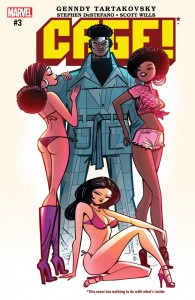 lineup change, to having the cover proclaim it’s a “Marvel Pop Art Production,” is clever, and a valentine for readers with a deep appreciation for the company’s history. Black Panther: World of Wakanda continues its focus on the two members of the Dora Milaje (the Panther’s female bodyguards; long story) who, in the main book, have broken off and started an idealistic revolution. This story explains their origin, amid a lot of soap-opera-ish dialogue and plot developments, as the two fall in love. This all plays a little too much like fanfic (it’s like you wrote about Tag and Bink from Star Wars having a torrid
lineup change, to having the cover proclaim it’s a “Marvel Pop Art Production,” is clever, and a valentine for readers with a deep appreciation for the company’s history. Black Panther: World of Wakanda continues its focus on the two members of the Dora Milaje (the Panther’s female bodyguards; long story) who, in the main book, have broken off and started an idealistic revolution. This story explains their origin, amid a lot of soap-opera-ish dialogue and plot developments, as the two fall in love. This all plays a little too much like fanfic (it’s like you wrote about Tag and Bink from Star Wars having a torrid  affair during A New Hope), but if your interests tend toward that kind of over-heated relationship drama, here it is. Cage! offers over-heated drama, too, but it’s on purpose, and tongue in cheek; TV animator Genndy Tartakovsky has a lot of experience walking the tightrope bewteen cartoony caricature and true adventure (see: Samurai Jack), and he uses it to good effect here, playing off of ’70s blaxploitation movies (just look at that cover…). Uncanny X-Men #16 is worth noting because it’s the first of the Inhumans vs. X-Men tie-ins, as Jean Grey and Fantomex try to contain the Inhuman
affair during A New Hope), but if your interests tend toward that kind of over-heated relationship drama, here it is. Cage! offers over-heated drama, too, but it’s on purpose, and tongue in cheek; TV animator Genndy Tartakovsky has a lot of experience walking the tightrope bewteen cartoony caricature and true adventure (see: Samurai Jack), and he uses it to good effect here, playing off of ’70s blaxploitation movies (just look at that cover…). Uncanny X-Men #16 is worth noting because it’s the first of the Inhumans vs. X-Men tie-ins, as Jean Grey and Fantomex try to contain the Inhuman  Karnak, maybe their most dangerous opponent, and keep him out of the main fight. Finally, The Punisher #7 is the last comic ever drawn by the late Steve Dillon (he seems to have drawn well over half of this issue, with Matt Horack providing the finishes and missing panels); considering how linked Dillon has been to Frank Castle’s history (he had a knack for depicting the book’s extreme violence in a simple, deadpan way that somehow made it seem even more horrible), it’s as good a swan song as any, and one last chance to appreciate one of comic’s most hard-working, individual artists.
Karnak, maybe their most dangerous opponent, and keep him out of the main fight. Finally, The Punisher #7 is the last comic ever drawn by the late Steve Dillon (he seems to have drawn well over half of this issue, with Matt Horack providing the finishes and missing panels); considering how linked Dillon has been to Frank Castle’s history (he had a knack for depicting the book’s extreme violence in a simple, deadpan way that somehow made it seem even more horrible), it’s as good a swan song as any, and one last chance to appreciate one of comic’s most hard-working, individual artists.
 Justice League vs Suicide Squad #1 (of 6) — Writer: Joshua Williamson; Art: Jason Fabok; Colors: Alex Sinclair
Justice League vs Suicide Squad #1 (of 6) — Writer: Joshua Williamson; Art: Jason Fabok; Colors: Alex Sinclair
Batman #13 — Writer: Tom King; Art: Mikel Janin; Colors: June Chung
Harley Quinn #10 — Writers: Jimmy Palmiotti and Amanda Connor; Art: Moritat, Joseph Michael Linsner, Bret Blevins and Inaki Miranda; Colors: Hi-Fi
Star Trek/Green Lantern #1 (of 6) — Writer: Mike Johnson; Art: Angel Hernandez; Colors: Alejandro Sanchez
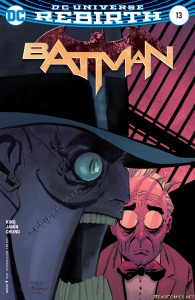 Cave Carson Has a Cybernetic Eye #3 — Writers: Gerard Way and Jon Rivera; Art: Michael Avon Oeming; Colors: Nick Filardi
Cave Carson Has a Cybernetic Eye #3 — Writers: Gerard Way and Jon Rivera; Art: Michael Avon Oeming; Colors: Nick Filardi
Lucifer #13 — Writer: Holly Black; Art/Colors: Marco Rudy; (Second Story): Writer: Richard Kadrey; Art/Colors: Ben Templesmith
Of the DC books, Justice League vs. Suicide Squad is the stand-out; it’s one of those books that, if you’re a DC fan, you’re probably going to buy no matter what. Fortunately, it’s pretty good: Williamson, who’s become known for a couple of Image series (Nailbiter and Birthright, especially) 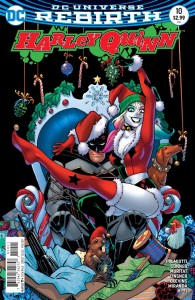 offers a carefully-constructed first issue, with a kickoff to an actual early fight between the two groups, and a last-three-pages reveal of an imposing lineup of behind-the-scenes bad guys (including the “original” version of a much-mocked New-52 character), led by yet another surprise bad guy (no, not Lex Luthor; no, not the Joker… think of someone with a deeper JLA connection instead); considering this is meant to be a weekly series, it should flash by both quickly and entertainingly, which is all you can reasonably ask for one of these events. Batman wraps up it own “Suicide Squad” story, with the Dark Knight fighting Bane and the Psycho Pirate with a hand-picked team of Arkham
offers a carefully-constructed first issue, with a kickoff to an actual early fight between the two groups, and a last-three-pages reveal of an imposing lineup of behind-the-scenes bad guys (including the “original” version of a much-mocked New-52 character), led by yet another surprise bad guy (no, not Lex Luthor; no, not the Joker… think of someone with a deeper JLA connection instead); considering this is meant to be a weekly series, it should flash by both quickly and entertainingly, which is all you can reasonably ask for one of these events. Batman wraps up it own “Suicide Squad” story, with the Dark Knight fighting Bane and the Psycho Pirate with a hand-picked team of Arkham 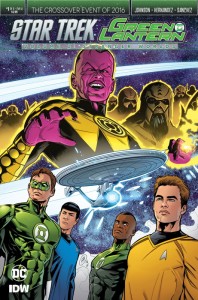 inmates. Since this is the conclusion, we find out why everyone got picked, and it’s a tribute to King’s plotting that it all makes sense, and that the various double- and triple-crosses all work out logically, too; if you squint a little, this even offers as a lead-in to JLA vs. SS, so it’s relevant and fun. Harley Quinn, also fun (as long as it’s written by Palmiotti and Connor, who seem to be the only writers besides Paul Dini who have a handle on her hard-to-grasp Brooklyn combination of crazy, innocent, sexy and self-empowering), has Harley going to see Santa and getting involved in a North Pole adventure, with guest artists like Moritat and Joseph Michael Linsner making the holiday very cheerful indeed, if
inmates. Since this is the conclusion, we find out why everyone got picked, and it’s a tribute to King’s plotting that it all makes sense, and that the various double- and triple-crosses all work out logically, too; if you squint a little, this even offers as a lead-in to JLA vs. SS, so it’s relevant and fun. Harley Quinn, also fun (as long as it’s written by Palmiotti and Connor, who seem to be the only writers besides Paul Dini who have a handle on her hard-to-grasp Brooklyn combination of crazy, innocent, sexy and self-empowering), has Harley going to see Santa and getting involved in a North Pole adventure, with guest artists like Moritat and Joseph Michael Linsner making the holiday very cheerful indeed, if 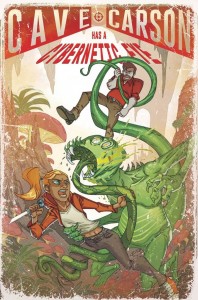 you ignore the seasonal blood, violence and slaughtered elves. Star Trek/Green Lantern is one of those books whose title is really all you need, especially if you read and liked the first of these crossovers last year. Cave Carson Has a Cybernetic Eye is, in its third issue, mostly action, as Cave, his daughter and the vigilante Mad Dog get chased by underground monsters and give his old Mole Machine a workout with some exploring, while the dimensions of the conspiracy against them become ever more clear. It’s cool post-modern fun, with Oeming’s art brisk, minimalist and perfect for
you ignore the seasonal blood, violence and slaughtered elves. Star Trek/Green Lantern is one of those books whose title is really all you need, especially if you read and liked the first of these crossovers last year. Cave Carson Has a Cybernetic Eye is, in its third issue, mostly action, as Cave, his daughter and the vigilante Mad Dog get chased by underground monsters and give his old Mole Machine a workout with some exploring, while the dimensions of the conspiracy against them become ever more clear. It’s cool post-modern fun, with Oeming’s art brisk, minimalist and perfect for 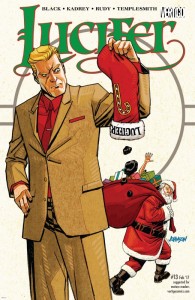 depicting all the over-the-top adventure. That leaves Lucifer, which takes a break from its ongoing story to offer two holiday tales set in the title character’s bar (making it closer to the TV show than most of this series has been); one’s by regular writer Holly Black, and has a callback to a plot thread from the Morningstar’s first comics series by Mike Carey, while the other, written by Richard Kadrey, features the horror artist Ben Templesmith; he doesn’t show up a lot, but his weirdly-lit, nightmarish drawing is always welcome, and this title is a perfect fit for his peculiar, hard-to-resist talents.
depicting all the over-the-top adventure. That leaves Lucifer, which takes a break from its ongoing story to offer two holiday tales set in the title character’s bar (making it closer to the TV show than most of this series has been); one’s by regular writer Holly Black, and has a callback to a plot thread from the Morningstar’s first comics series by Mike Carey, while the other, written by Richard Kadrey, features the horror artist Ben Templesmith; he doesn’t show up a lot, but his weirdly-lit, nightmarish drawing is always welcome, and this title is a perfect fit for his peculiar, hard-to-resist talents.
 Locke and Key: Small World #1 (of 1) — Writer: Joe Hill; Art: Gabriel Rodriguez; Colors: Jay Fotos
Locke and Key: Small World #1 (of 1) — Writer: Joe Hill; Art: Gabriel Rodriguez; Colors: Jay Fotos
Klaus and the Witch of Winter #1 (of 1) — Writer: Grant Morrison; Art: Dan Mora; Color Assists: Doug Campos
Dead Inside #1 — Writer: John Arcudi; Art: Toni Fejzula; Colors: Andre May
Of the indy first issues, Locke and Key: Small 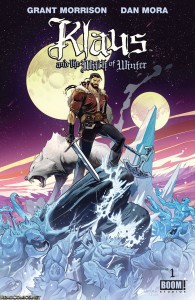 World is a one-shot return to Hill and Rodriguez’s creepy New England mansion and its reality-bending keys, this one unlocking a miniature version of the house that reflects everything in the real one, down to its inhabitants. Doesn’t matter: it all leads to a cool battle with a giant spider, and with no commitment to later chapters, so it’s worth it. So too for Klaus and the Witch of Winter, also a one-shot, involving Morrison’s superheroic version of Kris Kringle:
World is a one-shot return to Hill and Rodriguez’s creepy New England mansion and its reality-bending keys, this one unlocking a miniature version of the house that reflects everything in the real one, down to its inhabitants. Doesn’t matter: it all leads to a cool battle with a giant spider, and with no commitment to later chapters, so it’s worth it. So too for Klaus and the Witch of Winter, also a one-shot, involving Morrison’s superheroic version of Kris Kringle: 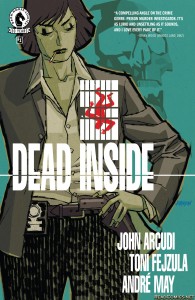 Morrison packs a mini-series’s worth of plot and story into the 42 pages here, while Mora nails a couple of big shots, helped by the book’s slick coloring and production values; as a handsome-looking modern Christmas fairy tale, it’s another effective stocking stuffer. Dead Inside, as the name might suggest, is hardboiled detective suspense, beginning with a curious prison murder. Arcudi’s been at this kind of thing for a long time, and is good at it; Fejzula has a stark woodcut-ish approach to the violence that reminds me of Ian Bertram (House of Penance), and effectively matches the noir tone.
Morrison packs a mini-series’s worth of plot and story into the 42 pages here, while Mora nails a couple of big shots, helped by the book’s slick coloring and production values; as a handsome-looking modern Christmas fairy tale, it’s another effective stocking stuffer. Dead Inside, as the name might suggest, is hardboiled detective suspense, beginning with a curious prison murder. Arcudi’s been at this kind of thing for a long time, and is good at it; Fejzula has a stark woodcut-ish approach to the violence that reminds me of Ian Bertram (House of Penance), and effectively matches the noir tone.
 Ether #2 — Writer: Matt Kindt; Art/Colors: David Rubin
Ether #2 — Writer: Matt Kindt; Art/Colors: David Rubin
Dept.H #9 — Writer/Artist: Matt Kindt; Colors: Sharlene Kindt
Peter Panzerfaust #25 — Writer: Kurtis J. Wiebe; Art/Colors: Tyler Jenkins; Additional Colors: Hilary Jenkins
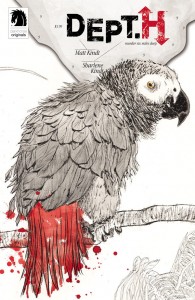 Archie #15 — Writer: Mark Waid; Art: Joe Eisma; Colors: Andre Szymanowicz
Archie #15 — Writer: Mark Waid; Art: Joe Eisma; Colors: Andre Szymanowicz
Usagi Yojimbo #160 — Creator: Stan Sakai
Ether and Dept.H are both from Matt Kindt; Ether, which he writes, is about dimensional gates to fairyland, and the cost they exact on the researcher who uses them (the gates’ transient nature, and the 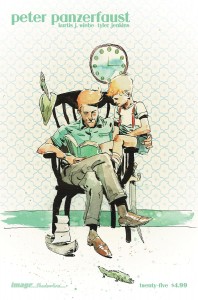 way the Earth hero helps out the other dimension’s residents with his practical Earther perspective, plays a lot like Adam Strange and the planet Rann); Dept.H, where Kindt’s both writer and artist, is about a woman investigating her father’s murder at a deep-sea research facility, six miles down; it’s a study in paranoia and claustrophobia and the terror of being trapped by rising water. Peter Panzerfaust, after a delay of over a year, publishes its concluding issue of its tale of a
way the Earth hero helps out the other dimension’s residents with his practical Earther perspective, plays a lot like Adam Strange and the planet Rann); Dept.H, where Kindt’s both writer and artist, is about a woman investigating her father’s murder at a deep-sea research facility, six miles down; it’s a study in paranoia and claustrophobia and the terror of being trapped by rising water. Peter Panzerfaust, after a delay of over a year, publishes its concluding issue of its tale of a 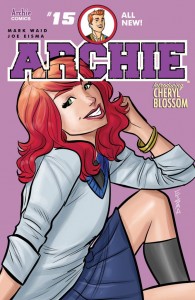 grown-up Peter Pan fighting for the French resistance during WWII; if you were initially fascinated by its high-concept conceit (and whether it would be handled smartly or dumbly), this is your chance to catch up and see what happened (good news: it turned out to be pretty smart after all). Archie continues its re-imagining of the Riverdale crew, ending a three-parter about Veronica in a European boarding school and meeting Cheryl Blossom; those
grown-up Peter Pan fighting for the French resistance during WWII; if you were initially fascinated by its high-concept conceit (and whether it would be handled smartly or dumbly), this is your chance to catch up and see what happened (good news: it turned out to be pretty smart after all). Archie continues its re-imagining of the Riverdale crew, ending a three-parter about Veronica in a European boarding school and meeting Cheryl Blossom; those 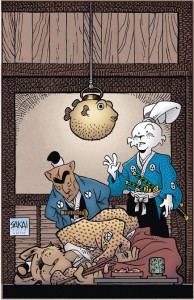 are sturdy characters, and this version treats them well; Waid knows as much about their continuity, and what makes them work, as he does about the Avengers — and to the same entertaining effect. Usagi Yojimbo offers another one-shot tale featuring Inspector Ishida, involving perfectly-prepared sushi, poisonous puffer fish, and tragedy; given its high quality, efficient storytelling power and all-ages audience, it’s your best buy as a last-minute present of the week, and the one most likely to be universally enjoyed.
are sturdy characters, and this version treats them well; Waid knows as much about their continuity, and what makes them work, as he does about the Avengers — and to the same entertaining effect. Usagi Yojimbo offers another one-shot tale featuring Inspector Ishida, involving perfectly-prepared sushi, poisonous puffer fish, and tragedy; given its high quality, efficient storytelling power and all-ages audience, it’s your best buy as a last-minute present of the week, and the one most likely to be universally enjoyed.



